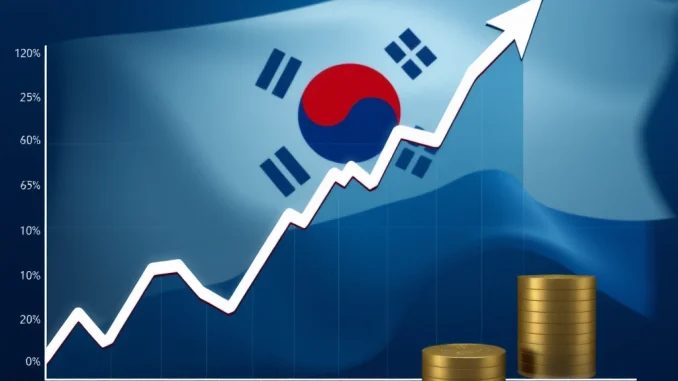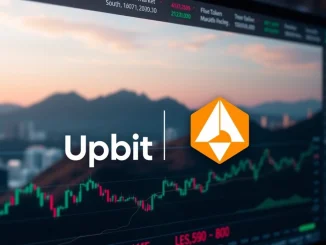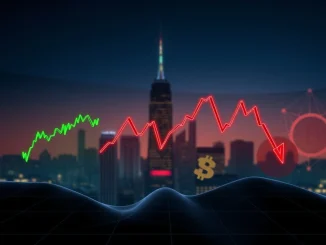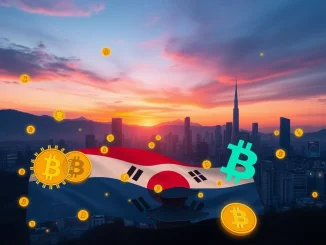
In a dramatic turn of events in the South Korean financial markets today, the KOSPI (Korea Composite Stock Price Index) experienced a moment of relief as market stabilization mechanisms kicked in. For those keeping a close eye on global market dynamics, especially within the cryptocurrency space, understanding these traditional market movements is crucial as they often foreshadow or influence trends in the digital asset world. What exactly happened in South Korea, and what does it mean for market volatility going forward?
Why Did KOSPI Need Market Stabilization?
The day started with significant volatility in the KOSPI 200 Futures market. Imagine the futures market as a predictor of where the main KOSPI index is heading. When these futures contracts, which represent the future value of the KOSPI 200 index, suddenly jumped by 5%, it signaled a potentially overheated market. This rapid surge triggered a pre-set mechanism designed to prevent runaway buying and ensure market stabilization. Think of it as a safety valve for the stock market, preventing excessive euphoria from creating instability.
Here’s a breakdown of the situation:
- Sudden Surge: KOSPI 200 Futures experienced a rapid 5% increase.
- Buying Sidecar Triggered: This surge automatically activated a ‘buying sidecar’.
- Market Halt: The buying sidecar temporarily halts buying activities in the market.
- Stabilization Goal: The aim is to cool down the market and prevent irrational exuberance from leading to a bubble or crash.
- First Time Since August: This is the first time this mechanism has been used since August 6 of the previous year, highlighting the unusual market activity.
What is a Buying Sidecar and How Does it Achieve Market Stabilization?
A buying sidecar is a market mechanism designed to inject a pause into trading when prices rise too quickly. It’s like a timeout in a basketball game, but for the stock market. Its primary function is to promote market stabilization by temporarily curbing excessive buying pressure. Here’s how it works:
- Volatility Detection: The exchange continuously monitors market movements, specifically looking at the KOSPI 200 Futures in this case.
- Threshold Breach: When the futures price hits a predefined threshold (like the 5% surge we saw), the sidecar is activated.
- Temporary Halt: Buying orders are temporarily restricted or halted for a short period, usually a few minutes. Selling can continue, allowing the market to find a more balanced level.
- Cooling Off Period: This pause gives investors a chance to reassess, preventing impulsive decisions driven by FOMO (Fear Of Missing Out) or panic buying.
- Orderly Trading Resumption: After the cooling-off period, trading resumes, ideally in a more controlled and stable manner.
Essentially, the buying sidecar is a tool to prevent sharp, unsustainable upward movements, contributing to overall market stabilization and investor confidence in the long run.
Why is South Korea’s Stock Market Important for Crypto?
While seemingly unrelated, events in the South Korea Stock Market, particularly the KOSPI, can have ripple effects in the cryptocurrency world. Here’s why:
- Global Market Sentiment: Traditional financial markets and cryptocurrency markets are increasingly interconnected. Instability or significant events in one can influence investor sentiment in the other. A stabilized KOSPI can contribute to a more positive global market outlook, potentially benefiting crypto markets as well.
- Korean Crypto Market: South Korea is a significant player in the cryptocurrency market. Korean investors are known for their active participation in crypto trading. The health of the South Korea Stock Market reflects the broader economic confidence in the country, which can indirectly impact crypto investment appetite.
- Risk-On/Risk-Off Behavior: When traditional markets show volatility, investors sometimes shift to or from riskier assets like cryptocurrencies. Market stabilization in KOSPI might be seen as a sign of reduced risk in traditional markets, which could influence investment strategies across asset classes.
- Economic Indicator: The performance of the KOSPI and the measures taken to ensure market stabilization are indicators of the economic health and regulatory environment in South Korea. These factors are closely watched by global investors, including those in crypto.
What Does This Mean for Investors and the Future of Market Volatility?
The activation of the buying sidecar in the KOSPI is a reminder of the inherent volatility in financial markets, both traditional and crypto. However, it also showcases the proactive measures in place to manage this volatility and promote market stabilization.
For Investors:
- Expect Fluctuations: Volatility is a normal part of market cycles. Mechanisms like buying sidecars are there to manage extreme swings, not eliminate them.
- Monitor Market Signals: Keep an eye on market indicators, including futures movements and the activation of stabilization mechanisms. They provide insights into market sentiment and potential shifts.
- Diversification is Key: Whether in traditional stocks or crypto, diversification remains a crucial strategy to mitigate risk during volatile periods.
- Long-Term Perspective: Short-term market corrections and stabilization efforts are part of the bigger picture. Focus on long-term investment goals rather than getting swayed by daily market noise.
Looking Ahead:
- Continued Monitoring: Market regulators will likely continue to monitor volatility closely and adjust mechanisms as needed to ensure fair and stable trading.
- Global Implications: The effectiveness of market stabilization measures in markets like South Korea can influence regulatory approaches in other countries and potentially even in the crypto space.
- Technological Solutions: As markets evolve, expect to see further development and refinement of technological tools and mechanisms aimed at managing volatility and ensuring market integrity.
Conclusion: A Moment of Calm in KOSPI – What’s Next?
The market stabilization triggered by the buying sidecar in South Korea’s KOSPI is a significant event, albeit a temporary one. It underscores the importance of market safeguards and the interconnectedness of global finance. While it provided a moment of calm today, the broader economic landscape and market dynamics remain in constant flux. For crypto enthusiasts and investors, understanding these traditional market movements provides valuable context and reinforces the need for informed, strategic decision-making in the ever-evolving world of finance.



